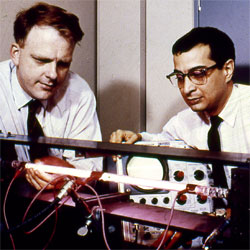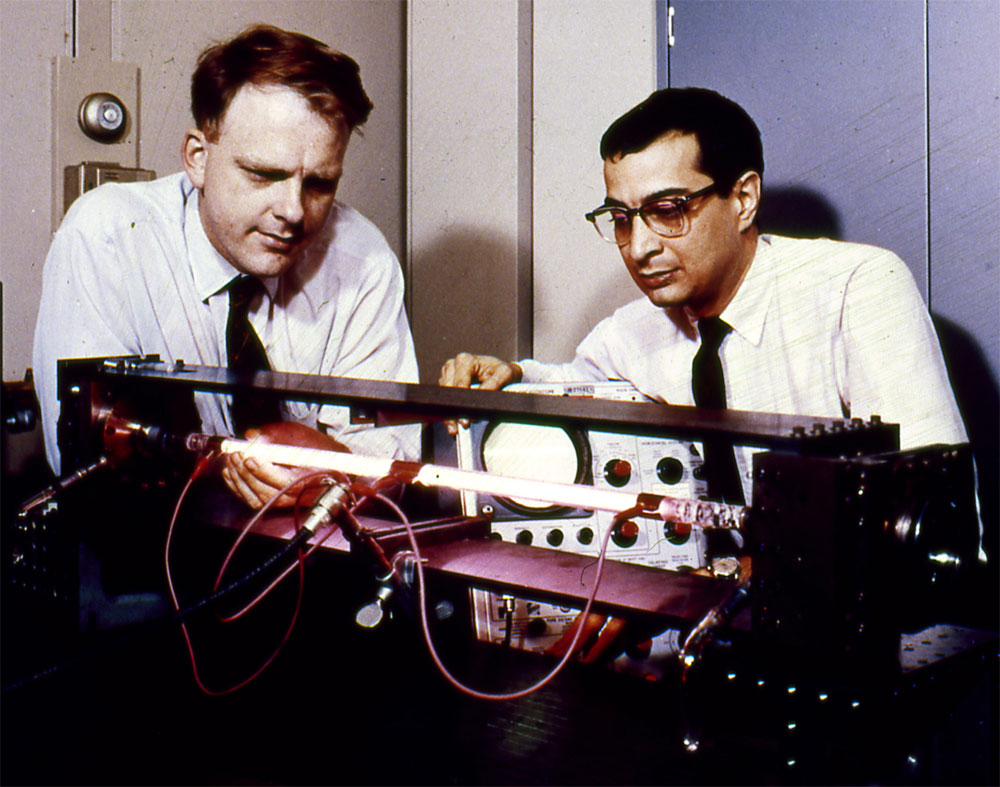Landmarks: The First Laser to Stay On
Focus Landmarks feature important papers from the archives of the Physical Review. During 2010, the 50th anniversary of the invention of the laser, we’re highlighting some laser-related papers, as part of LaserFest.
The first laser, built in 1960, used a ruby. But just a few months later, a report in Physical Review Letters described a very different kind of laser, using a mixture of helium and neon as the active medium and producing a continuous beam rather than a series of pulses. Not long afterwards, a Physical Review paper reported a laser based on carbon dioxide. Their ease of construction, efficiency, and versatility made gas lasers a dominant technology, both scientifically and commercially, in the decades following their invention.
Lasers work by creating a so-called population inversion–for example, by exciting a large number of atoms to a high energy level, while a lower level remains largely unoccupied. If the excited atoms are inside a suitable optical cavity, photons emitted in the decay of the excited state bounce back and forth, stimulating identical photons from the decay of the remaining excited atoms.
The ruby laser achieved a population inversion by “optical pumping,” in which a flash of light from a xenon-filled fluorescent tube excited chromium atoms, which then generated a pulse of red laser light [1]. A year earlier, however, Ali Javan of Bell Laboratories in Murray Hill, New Jersey, had described how fluorescent tube physics could be used to pump a laser in a different way [2]. He showed that a voltage applied across a tube of helium atoms (a “discharge” tube) could excite them to a relatively long-lived state that happens to be close in energy to an excited state in neon. In a mixture of the two gases, excited helium atoms can transfer their energy to neon atoms through collisions, putting large numbers of neon atoms in a high energy state.
Working with Bell Labs colleagues William Bennett and Donald Herriott, Javan spent several months turning this idea into a working device. In practice, electric discharge pumping can excite more than one state in neon, so that laser action at a number of wavelengths is achievable. The Bell Labs team filled a quartz tube, 80 centimeters long and 1.5 centimeters in diameter, with a roughly 10:1 mix of helium and neon and placed reflectors at either end that were most efficient in the wavelength range of 1100 to 1200 nanometers. The strongest laser emission Javan and his colleagues reported was at 1153 nanometers, in the near infrared. Because the electrical discharge can excite helium at the same time that the neon atoms are emitting photons, the new gas laser was able to produce a continuous, not pulsed, beam of coherent light. About six months later, another pair of Bell Labs researchers made a similar device operating at the red wavelength of 632.8 nanometers–the “He-Ne” laser commonly used today [3].
Another Bell Labs researcher at the time, C. Kumar N. Patel, now at the University of California, Los Angeles, says he began considering gases of molecules rather than atoms because “I wanted high power and high efficiencies.” In atomic gases, he explains, the levels involved in laser action are high above the ground state, so that the energy needed to pump to the higher state is significantly greater than the laser energy. Molecular levels, by contrast, are closer to the ground state, so that a greater fraction of the pumping energy turns into laser output. In 1964 he reported an infrared carbon dioxide laser with two operating wavelengths near 10 microns. The following year he greatly improved the efficiency of the laser by adding nitrogen, which performed the same role as helium did in the He-Ne laser [4].
Gas lasers produce monochromatic light with very stable frequencies, making them useful for precision length measurements and other technical applications, says Peter Milonni of Los Alamos National Laboratory. They were also for many years the most powerful laser technology, because excess heat could be carried away by flowing the gas through them, he adds. The laser is still widely used in surgical devices because its infrared light readily heats biological tissues, but the red He-Ne laser, once common in check-out scanners, CD players, and other familiar devices, has now largely been supplanted for such uses by the semiconductor laser [see Focus Landmark from July].
–David Lindley
David Lindley is a freelance science writer in Alexandria, Virginia.
References
- T. Maiman, “Stimulated Optical Radiation in Ruby,” Nature (London) 187, 493 (1960)
- A. Javan, “Possibility of Production of Negative Temperature in Gas Discharges,” Phys. Rev. Lett. 3, 87 (1959)
- A. D. White and J. D. Rigden, “Continuous Gas Maser Operation in the Visible,” Proc. IRE 50, 1697 (1962)
- C. K. N. Patel, “CW High Power N2-CO2 Laser,” Appl. Phys. Lett. 7, 15 (1965)
More Information
Invention of the Maser and Laser (Focus 2005) Landmarks: Invention of the CD-Player Laser (Focus 2010) laser history from Bell Labs J. L. Bromberg, The Laser in America: 1950 - 1970 (MIT Press, 1991)





